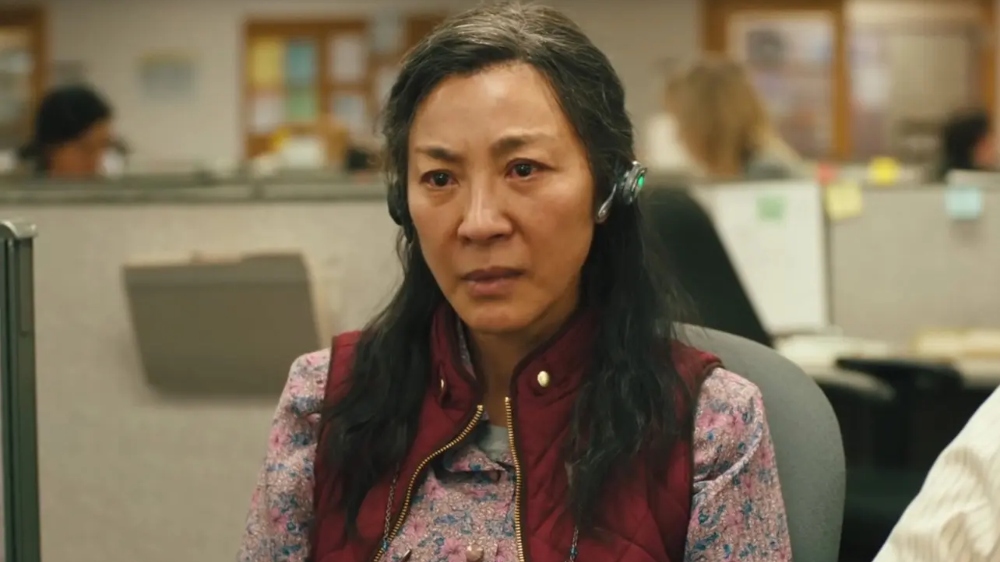
Continuing our coverage of Daniels’ Everything Everywhere All at Once, the absurdist sci-fi action comedy starring Michelle Yeoh that has been doing impressive business at the box office despite one of the oddest premises of any movie to hit theaters this year.
The intricate concept for the film thrusts Yeoh’s Evelyn Wang (and the rest of her dysfunctional family) into a number of alternate universes where we see how things may have turned out differently if she had made other choices. Creating this device involved many montages, but also a lot of equally complicated editing to make the storytelling seamless.
That onus fell upon Editor Paul Rogers, who had previously worked with Daniels on some of their music videos, though much of his work has involved editing The Eric André Show on Adult Swim, which shares a certain sensibility with Everything Everywhere.
Below the Line spoke with Rogers a few weeks ago, so please enjoy our chat below:

Below the Line: While researching this, I learned that you and VFX Supe Zak Stoltz worked with Daniels on their music video for “Turn Down for What,” though neither of you worked on Swiss Army Man.
Paul Rogers: Yeah, Matt Hannam cut Swiss Army Man, who’s a good friend and an incredible editor. He actually gave me a lot of great working advice for this film. Right before I started on Everything Everywhere, I went out for drinks with Matt and just kind of picked his brain, because I’ve worked with Daniels for years, but I hadn’t worked on a project of this scale and for this long. Everything we did was a music video or a short film. I did a feature with Daniel [Scheinert], but not with Dan Kwan, so he was actually really helpful, just giving me advice on the workflow with them. And it was great.
BTL: How long ago did you find out about Everything Everywhere, and what was Daniels’ pitch like? What did they tell you about the movie, or did they just give you a completed script in some form?
Rogers: I had known they were working on the script, but they hadn’t told me a lot about it. Dan Kwan has an office in his garage — it’s where they cut Swiss Army Man with Matt — so they invited me one day — Dan and Daniel — to sit there with [Producer] Jon Wang, while they pitched the movie to us, which basically was the length of the film — almost two hours or something — of them acting it out, just telling the story scene by scene, saying bits of dialogue, sometimes acting it out physically. They had this whiteboard behind them with just bits and pieces, random words scrawled, like “hot dog fingers” and “Racacooney”, and you’re reading that as they’re telling the story, and you’re just like, ‘What is this?’ Slowly, as they tell it, it becomes clearer, and each piece kind of makes sense and fits together.
There’s a scene like halfway through that brought me to tears, I started crying, and then it happened again a little bit later. Eventually, I was like, ‘I should keep track of how many times I cry.’ By the end of it, I had counted four times. Just them telling the story had made me emotional. That’s how I heard about it, and at this point, it was the same story, basically, but it had a lot of different elements to it, and some stuff that ended up not making it into the final shooting script. But it was the same basic bones and emotional arc and approach, and it was incredible.
BTL: Was that your own private performance that they gave you?
Rogers: Kind of, yeah. I don’t know how many times they’ve done it before this, but it felt like they were performing it for the first time. That’s because they were so excited, and just kind of riffing off each other.
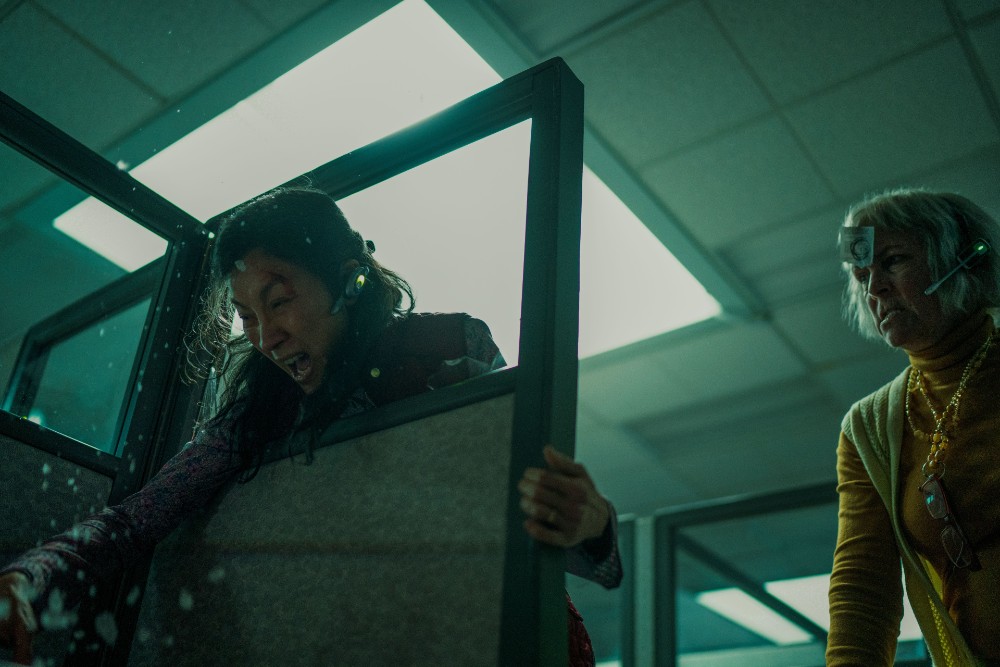
BTL: How long was it between that performance and them being on set shooting the film? And did you get a script before then to figure out how a few things would be done?
Rogers: I basically got the final shooting script. I don’t think I got anything before that, so it was pretty close to when they shot. I feel like [that pitch] was a year or two before they shot, and a couple months before they shot, I got my script. It was changed a lot, but not the message. A lot of it was the same, but they had gender-swapped it. It used to be about a father and daughter, and now, it was about a mother and daughter. It was a lot more lean. Before, I was just excited about the story and excited to see the film when they got the green light to make it. Once I was reading that first draft of the script, I was like, ‘Shit, now I gotta figure out how it’s actually gonna work, editorially.’
BTL: I have to assume Daniels and their DP Larkin Seiple storyboarded a lot of this movie to figure some of the montages and such out in advance.
Rogers: I’m sure. I didn’t get any storyboards, and I know that Larkin had pushed for pretty thorough storyboarding. I don’t know how that ended up. I tend to work in this way, and for better or worse, I enjoy working in a way where I don’t do my first cut-off of those. I just react to the footage and cut it together how I think it wants to be cut together, scene by scene. And then, I go back to the script and reread and adjust if I need to. So I didn’t have any storyboards, and I didn’t ask for any storyboards. Obviously, it was incredibly well-thought-out, but there was also a ton of experimentation on set, from what I could see. I think they shot a lot of what they knew was going to work, and then they also left a lot of room to experiment and do a bunch of stuff that they were like, ‘We don’t know how this is going to fit into the final film, but we want to get this, because what Stephanie Chu is doing here is really special,’ or ‘Michelle’s idea for this scene is really special, and we want to get it, just in case we can make it work.’ A lot of that stuff ended up making it in because they were that open to improv and the experimental nature on set.

BTL: I’m surprised you didn’t see the storyboards because there seems to be a lot of stuff where things would need to cut together seamlessly to make it work, or is that stuff that you can work on with Zak in post?
Rogers: I know that they had a lot of forethought in the way that they were shooting this stuff to make sure that it worked. They come from an editing background and from a VFX background of having done all their own editing and VFX in the past. So they shoot with that in mind, which is such a blessing for me and for Zak, who was on set with them every day. He was making sure that the stuff was going to work in VFX, but as far as my role there, either purposely or just because of the way that I tend to work, I wasn’t clued in on those storyboards as much as I could just pick Dan or Daniel’s brain and be like, “Hey, how did you picture this working together? How do you picture this thing cutting?” Or just experimenting and finding new ways. A lot of how we were getting from universe to universe we just figured out. Not all of it, but a lot of it was just like, “Let’s experiment and figure out what feels good.”
BTL: Were you being fed footage while they were shooting pretty much?
Rogers: Yeah, I was technically “on-set editor,” I would say with finger quotes, but I wasn’t sitting on set with them. So I would cut from my office in Highland Park, which is like a 30-minute drive from their set, and send them links on Frame.io and get notes, or I would drive over with a drive and a laptop and show him stuff. I wasn’t getting, like, big notes. We weren’t assembling a cut persé, but it was more like, ‘Hey, we shot this scene. We want to make sure it all works before we like completely break down the set. Can you just do a quick assembly of it?’ That was a lot of what I was doing. One of the first things I cut together was the audit sequence where she first meets Jamie Lee’s character. Right after that, I cut the fanny pack sequence. They ended up showing that on set, so I went to set for that, and sat while they projected it for all the actors – that was a really special moment.
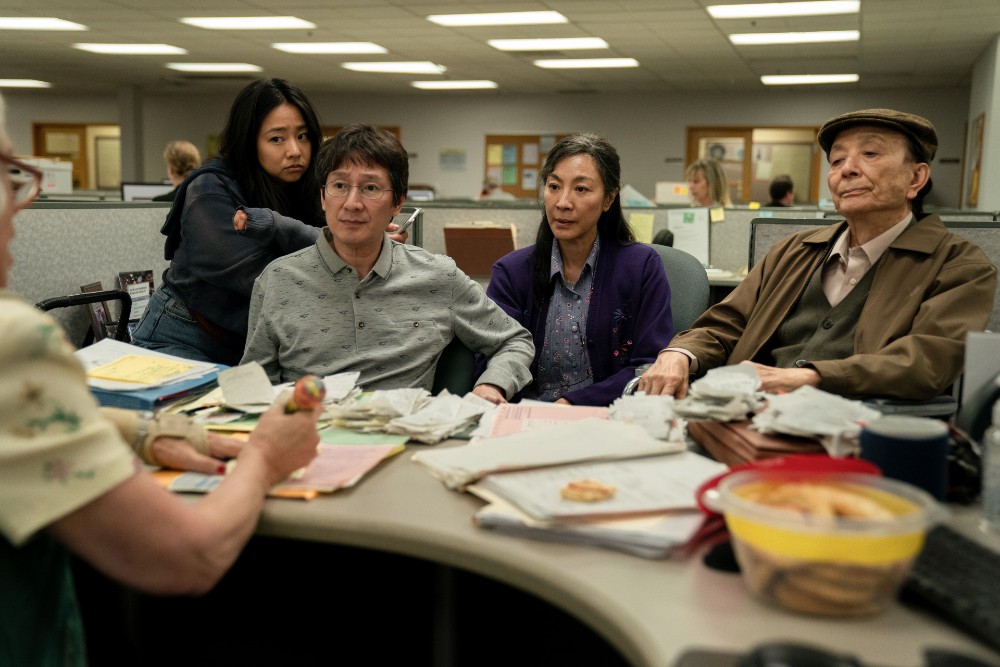
BTL: There are many montages to explain the Evelyns from different universes, showing her different lives, so were those all a part of the main shoot? How did you work with them to put those together?
Rogers: A couple, like the movie star universe, are a collection of stuff they shot with stock footage from Michelle Yeoh’s actual red carpet events, signing autographs, so that’s a lot of experimentation of how that’s going to work. It was two years ago, I guess, that we cut this, so I’m having to go back in my brain about what the process was. None of those montages were necessarily shot by shot planned out editorially, as much as they just shot what they knew was going to work, and they had faith in the editorial process that it was going to all come together. The montages were really a creative playground for me and for Dan and Daniel because we work in a way where they’re getting their hands dirty in the edit constantly, so they’re jumping in and playing with timelines and playing with shots, things like that.
BTL: Larkin tried to explain the timeline of how they were almost done with initial production when COVID hit, and they then had to shoot stuff with Michelle in Paris on green screen. Where were you at when COVID hit? Were you just starting to cut things together on your own?
Rogers: We were just getting started at that point. I think they had a day left of shooting, and I don’t think there was an official lockdown at that point until like the following weekend. They took a week off, and I got started in the office, and then all of a sudden, everybody had to be remote. We had to figure out, ‘How do we do this? Can we do this? Does the movie stop? Or do we figure out a way to work over Zoom?’ We tried everything in the beginning. We were remote for basically the entire offline edit. It ended up working really well. We had weird schedules because I was doing childcare during the day and working on the movie at night. It was just a strange thing, but we made it work. It ended up being a really, really great thing to have during the pandemic because it was an excuse to talk to my buddies every day, and also a nice distraction to have this big giant movie. There’s always something to be done or something to think about, versus the state of the world. It was also just a really beautiful story and something that made you feel good to work on. In all those ways, it was such a blessing.
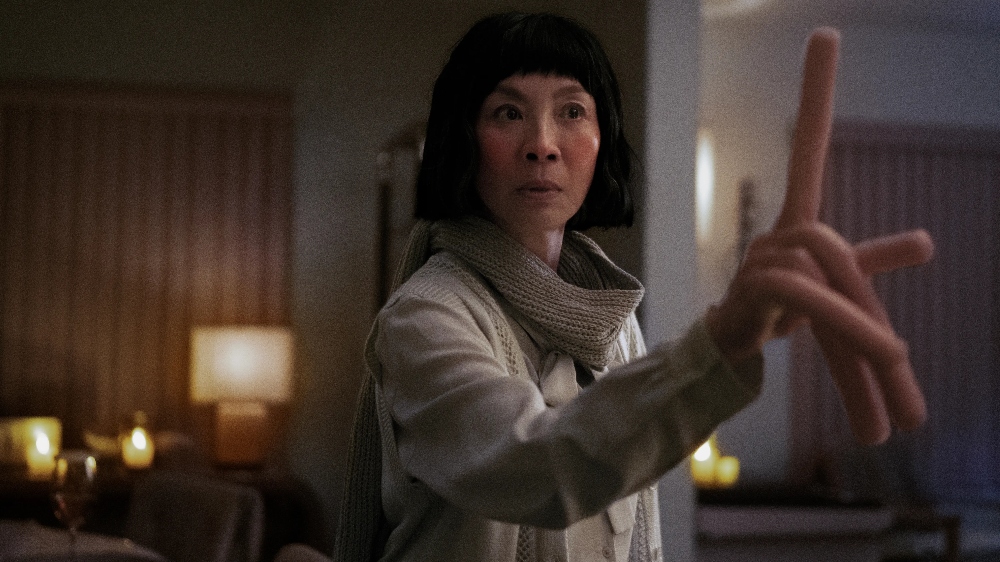
BTL: When did you finish your “first cut,” or were you editing and finagling things right up until the end?
Rogers: No, I think we had like 12 or 13 cuts total, but we finished the first cut in a couple of months, and we did a screening. Basically, we sent out a link and jumped on Zoom, where we invited a couple of friends and just watched their faces on Zoom while they watched the cut, and then, we asked them some questions. We would do that every couple of weeks. It was a screening process that I think their editor from Swiss Army Man, Matt Hannon, had kind of passed on to them, which is just like, “Once you have a cut. Every two weeks, you screen wherever you’re at to get reactions.” We tried to stay as close to that as possible. Sometimes, every two weeks was a lot. A couple of months after they wrapped shooting, we had a cut, and then we just did screenings and screenings and iterations and iterations. This movie is just like iteration after iteration, trying new things, pushing it too far, reining it back in, finding the balance, and trying new things. A lot of times we would have scenes that worked really well, and we would blow them up and try something completely new just to see if there was anything else that we could squeeze out of it.
BTL: Were the Daniels able to work in the same room as each other during the post process?
Rogers: No, we were all in our respective homes. I didn’t have a home office at that point. I was in my living room on an iMac with my kid behind me eating dinner and watching Mister Rogers and my wife like right behind me on her computer working remotely for her job. We were all just figuring out a way to make it work.
BTL: How does Zak fit into things as far as the visual effects? Does he wait until you have the first edit, or was he involved with all those different iterations you mentioned?
Rogers: Zak was very involved. It was really nice the way that we worked with Zak, because we could send him a shot and be like, ‘Can you just do a quick and dirty version of what this might look like?’ or ‘Clean this up a little bit to help us imagine it.’ He could get it back to us a day later, sometimes, or even faster, a couple of hours later. That was a really incredible way to work, and it also really helped with our first rough cuts to have at least some of the effects in there. Because if you’re just imagining this bagel, and there’s nothing there, it’s really hard for an audience to get behind that. He was able to experiment really early and get us a bunch of options for the early cuts.
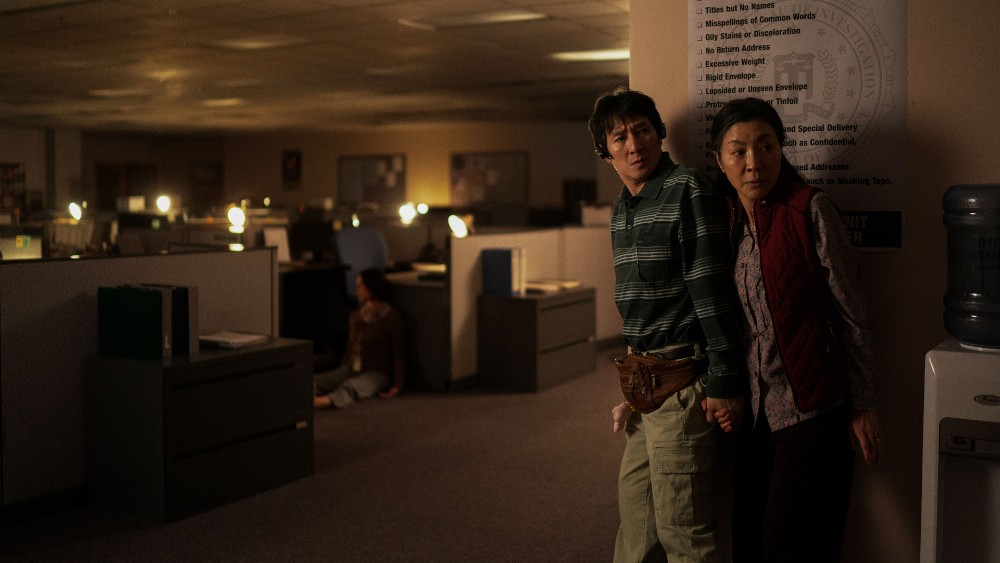
BTL: Son Lux composed the score, so were they giving you any music to cut to in advance?
Rogers: Oh, yeah. Son Lux was incredible. They sent us basically their entire back catalog of everything they had ever made, both solo projects, and as Son Lux, as instrumentals, so we had this incredible catalog of music from them. Our very first cut before they composed anything still sounded like the movie. It was still spiritually in the same zone, because it was all them. And then, very only on, we were jumping on meetings with them and sending them scenes and talking through stuff. They were able to get us a lot of really early rough cuts of the cues that we could use in the edit, and that really helped us kind of find the [emotional] moments of the film musically. It was really, really wonderful, and it also helped us not get too in love with just random temp music. Just being in the same zone as Son Lux was really nice.
BTL: When I spoke to some of the people who worked on The Batman, which also got hit by the COVID shutdowns, they said that the lockdown actually helped them work a few things out by giving them more time. Was that the same with you guys in terms of figuring things out?
Rogers: Yeah, totally. I think there was one point when we realized that we had just reached what would have been the lock date. If we hadn’t locked down and where we were, we had a movie, and we had a good movie, but we didn’t have the movie that we wanted yet. We didn’t have a great movie, so it was really nice to have this extra time. A24 was really great. They were just like, ‘Look, we don’t know what’s happening in the world, so you just keep making the movie until you’re done,’ and where we ended up — however many months after that original lock date – was with a movie that was so different and so much better. Now, it just makes me feel like this is how we should be making movies. We should be really giving them time in the edit to find themselves, because of the level of experimentation that we were able to do. Like I told you earlier, you could take something that’s working and completely throw it out and try again from the ground up. You just can’t do that when you’re under a really tight timeline. It just doesn’t make sense — it’s irresponsible to do that. In this case, we just had that freedom, and that was where a lot of fruitful discoveries were made.
Everything Everywhere All at Once is still thriving in theaters — in this universe and beyond. Click here for our recent interview with DP Larkin Seiple and stay tuned for our interview with VFX Supe Zak Stolz and some of his team next week. And if you haven’t seen it yet, click here to check out Paul’s editing on Daniels’ amazing “Turn Down for What” video.





